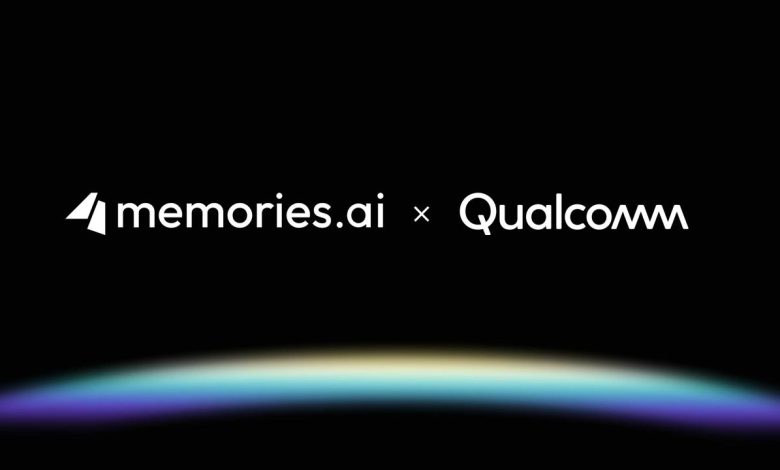
As large tech companies are poised to ship billions of AI-powered phones, glasses, and robots over the coming decade, one crucial technology gap remains: memory.
Text is easy for machines to remember. Video isn’t. It’s dense, unstructured, and locked to a timeline. Most software still leans on file names, transcripts, or rough thumbnails. That misses actions, objects, and the context that happens between frames. Teams scrub hours of footage and still miss key moments. If AI is going to answer “what happened?” and “when did it happen?” from video, it needs a memory layer built for sight, not just sound or text.
Today, Memories.ai is one step closer to solving that problem. The startup introduced its Large Visual Memory Model 2.0 (LVMM 2.0) and a collaboration with Qualcomm Technologies to run it natively on Qualcomm processors starting in 2026. The goal is simple: turn raw video into searchable, structured “memories” that you can query on the spot.
What LVMM 2.0 does
Memories.ai’s system ingests video, encodes frames, compresses them, and builds an index on the device. It fuses video, audio, and still images, so search results carry context. You can ask a plain-English question or show an image as a cue and jump straight to the exact moment. The company says searches resolve in under a second and improve as more footage is indexed over time.
Running on Qualcomm chips brings three clear benefits: lower latency, lower cloud costs, and better privacy since data stays local. A unified memory format aims to keep behavior consistent across phones, cameras, wearables, and other edge systems. Developers get SDKs and reference designs to add capture, indexing, and retrieval without rebuilding their backends.
Qualcomm’s role
“By combining Qualcomm’s expertise in edge computing, connectivity, and on-device AI with Memories.ai’s innovative Large Visual Memory Model (LVMM), we are transforming how machines perceive, learn, and remember,” said Vinesh Sukumar, VP, Product Management and Head of Gen AI/ML at Qualcomm Technologies, Inc. “This collaboration will enable AI platforms that are not only responsive but also context-aware, able to retain visual information, recognize patterns over long periods, and perform reliably even at the edge of networks. Together, we are speeding up our shared goal to deliver smarter, more intuitive intelligence to real-world applications.”
Translation: Qualcomm supplies the silicon and on-device AI tooling; Memories.ai supplies the visual memory stack. If it works as described, video becomes as searchable as text, but without sending everything to a data center first.
Use cases the company is pushing
- AI albums on phones. Organize and resurface personal video memories on device.
- Smart glasses and wearables. Give assistants long-term visual recall so they can answer “have I seen this part before?” without a network.
- Security agents. Let cameras understand and respond to events in real time, not after a batch upload.
- Robotics. Improve context for navigation and task execution with persistent, queryable visual memory.
These are not new ambitions. The claim is that doing them on-device makes them practical: faster responses, fewer privacy headaches, and lower operating costs.
On-device AI is moving fast for text and images. Video lags because it’s heavier and more context-dependent. LVMM 2.0 tries to narrow the gap by compressing what matters and indexing it in a way general-purpose models can query. The company frames this as a building block, not a final app. Phone makers, camera vendors, and software developers are the target customers.
What’s new in 2.0
- On-device first. Native execution on Qualcomm processors targeted for 2026 hardware.
- Multi-modal fusion. Video, audio, and images combined for more precise recall.
- Unified memory format. Same interface across phones, cameras, and edge devices.
- Developer kit. SDKs and reference designs for capture → index → retrieve.
The company did not disclose model size, throughput numbers, or battery impact. Those details will matter to partners and buyers. Pricing was not shared.
The privacy angle
Keeping video analysis local is a strong story for consumers and enterprises. Many teams can’t ship sensitive footage to the cloud. Local processing reduces exposure, narrows who touches the data, and limits compliance scope. It also cuts down on bandwidth and inference bills. If performance holds, this becomes a straightforward TCO pitch.
Plenty of tools index video audio tracks and let you jump via transcript. Others tag frames with object labels. The hard part is persistent, context-rich recall across long time spans and devices, without sending everything to a server. Memories.ai positions LVMM as that memory layer. As with any platform bet, adoption by OEMs and developers will be the test.
“Qualcomm has proven themselves as a leader in bringing AI to the edge,” said Shawn Shen, co-founder and CEO of Memories.ai. “We’re thrilled to partner with them to bring the incredible power of LVMM’s to hundreds of millions of phones, computers, and wearables in the coming years.”
Timeline and availability
Memories.ai says LVMM 2.0 will run natively on Qualcomm processors starting in 2026. The company points interested developers and partners to memories.ai for more information. Specific launch devices, partner apps, and regions were not announced.
In July 2025, Memories.ai launched from stealth with its Large Visual Memory Model and $8M in seed funding from Susa Ventures, Samsung Next, Crane Venture Partners, Fusion Fund, Seedcamp, and Creator Ventures. It has since made waves for offering a bounty for top AI researchers to join its team from leading AI labs.
Bottom line: If Memories.ai and Qualcomm deliver on-device visual memory at scale, video search could feel as fast and natural as text search. The technology case is clear. Now it’s about execution, battery life, and developer adoption in 2026 hardware.
Companies can learn more at: https://memories.ai




